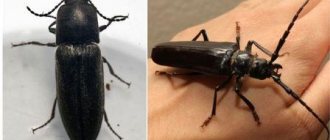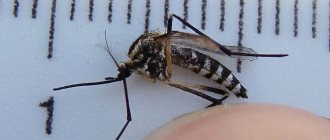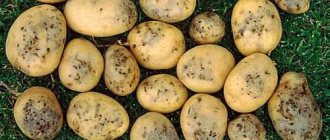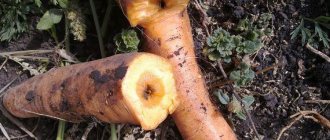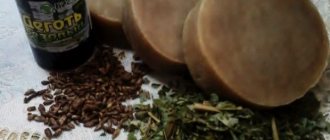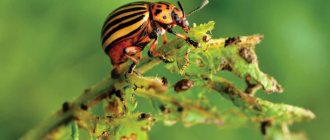The click beetle or wireworm poses a serious threat to gardens and vegetable gardens. The pest prefers acidified soil, high humidity, and dense thickets of wheatgrass. In other words, this pest is omnivorous, so it can cause irreparable damage to future crops. If the wireworm is not dealt with, the area can turn into a real colony of these pests, where you can find parasites of different ages.
The article talks about what the pest looks like and how to deal with it. The main attention is paid to preventing the appearance of click beetles in the garden.
Where are beetles found and what do they eat?
Click beetles love to eat any root vegetables, their favorite delicacy is potatoes, but parasites multiply in any land where there is any vegetation.
Wireworms do not disdain weeds, they even lay their eggs on them (burdock, wheatgrass). The formed larva moves to the upper layers of the soil, where there is a sufficient amount of moisture and nutrients. In the apartment, some may notice adult individuals that have entered through open windows. Immediately destroy the parasite and prevent egg laying. Parasites love to live in food supplies and actively feed on potatoes
It is important to remove spoiled root vegetables in a timely manner.
What is a wireworm (larva of a click beetle): what it looks like and why it is dangerous
Wireworms are the larvae of the click beetle (also sometimes called the wireworm). This beetle received this name because if you catch it and turn it on its back, and then slightly touch it with a finger or a twig, it begins to make sounds similar to clicks. The beetle is practically not dangerous, unlike its larva, whose lifespan can reach 3-4 years.
The life cycle of the click beetle and its wireworm larvae consists of the following stages of development:
- With the onset of warmth, around the end of April, the beetles, which had previously spent the winter in the ground at a depth of about 20 centimeters, begin to wake up and come to life.
- The adults mate and the females begin laying eggs (up to 200 eggs), from which tiny larvae (3-4 mm) emerge after 3-4 weeks.
- To satisfy their hunger and gain weight, the larvae begin their race in the soil in search of food, eating up and destroying the thin roots of weeds. Therefore, weeds should not be allowed to grow in the garden.
- The next year, the larvae grow to 12-15 mm, and their bodies become tougher.
- At the 3rd year of life, they become completely tough (hence the name - wireworms) and can already penetrate root crops, gnawing holes in them.
- The larvae pupate and develop into adult click beetles.
What kind of root crops are not damaged by this underground pest: potatoes, carrots (although, as a rule, these are the larvae of carrot flies), beets, onions. In addition, he can even eat young spruce seedlings.
In nature, there are more than two and a half thousand species of click beetles. They live everywhere: from the southern regions to the Arctic. The most common are dark, striped and steppe beetles. It is impossible to confuse this malicious pest with another insect.
Click beetles, which live in the tropics, have more varied colors. It comes in red, orange, yellow, blue, green colors. Often, beetles have various patterns in the form of spots and lines on the pronotum and elytra. The whiskers are clearly visible and can be combed, jagged or serrated. Moreover, in females they are shorter. Adult insects grow up to thirty millimeters in length.
The click beetle, the photo of which you see in the review, in late spring - early summer lays white or cream-colored eggs, which during development absorb a lot of water, which increases their size by about one and a half times. The masonry is placed in small piles in the top layer of soil.
Varieties
In total, there are about 12,000 species of click beetles, of which 700-750 are found in the CIS countries. Many varieties of click beetles cause irreparable damage to garden crops.
One of the most common species is the dark click beetle. Its chitin is brown-black, sometimes rusty-brown. The upper elytra are framed by gray hairs. The larvae are yellow-brown and can reach 25 mm in length. The last segment of the wireworm is equipped with dimples similar to spiracles.
The larvae of black click beetle and turf grass mainly damage potatoes and vegetable crops. The larvae of the striped, dark and shiny beetles damage sunflowers and all cereal crops.
An equally dangerous pest is the small click beetle. The length of its body can reach 6-9 mm, width - 1.2-2.8 mm. Chitin is brown in color. It mainly harms grain crops, peanuts, beets, and sunflowers.
The striped (bread) click beetle has an oval elongated body 7-10 mm long. The elytra are dark brown. It feeds mainly on the roots of cereals.
The steppe click beetle damages almost all agricultural crops. The body reaches 9-13 mm in length, the width varies between 2.9-4.5 mm. The head is coarsely punctured. The pronotum is black, the elytra are brownish-black.
Another omnivorous species of beetle is the black click beetle. The body is completely black; a metallic tint may appear. Body length varies between 10-14 mm.
In Central America, there is a species of click beetle that can emit quite bright light. The Indians tied beetles to their legs to light the way at night.
The Parreis click beetle is considered the largest click beetle of the Russian fauna. The length of its body can reach 35 mm. It is included in the register of the Red Book of Russia.
Click beetle
The click beetle or wireworm poses a serious threat to gardens and vegetable gardens. The pest prefers acidified soil, high humidity, and dense thickets of wheatgrass. In other words, this pest is omnivorous, so it can cause irreparable damage to future crops. If the wireworm is not dealt with, the area can turn into a real colony of these pests, where you can find parasites of different ages.
The article describes what the pest looks like and how to deal with it.
The main focus is on preventing the appearance of click beetles in the garden
Click beetle: description
Scientists know about more than 2 and a half thousand species of this pest of gardens and vegetable gardens. It can be found almost everywhere, even in the most seemingly unfavorable conditions for it.
The most widespread are steppe, striped and dark beetles. It is extremely difficult to confuse this pest with other types of pests. Adults grow up to 2 cm in length, have an oblong body, and the head occupies almost 2/3 of the body. The beetle may be black, brown or purple in color.
The beetle got its name due to the fact that when it jumps, it makes a sound similar to a click. Therefore, it is easy to distinguish it from other types of pests. You can often see various, rather intricate patterns on the beetle's wings or foredors.
It takes up to 5 years for an egg to develop into an adult click beetle. With the arrival of spring, females climb out of the ground through cracks in the ground, where they lay eggs. They are capable of laying up to one and a half thousand eggs, but for safety, they lay 5 eggs in each hole.
About a month later, voracious larvae emerge from the eggs. The first year of life is characterized by the fact that they do not cause significant damage to the crop, and only in the second year of life can real trouble be expected from them.
The wireworm has a strong body structure, which allows it to easily make thick passages in root crops. During this period, they eat swollen buds, young tubers, shoots and the root system of plants. The larvae pupate over several years and in the spring adult beetles emerge from the pupae, ready for further reproduction.
Diet of click beetles
These pests are considered omnivores, so their diet includes any root crops that the owner grows in his garden or summer cottage. He loves potatoes most of all, although they can be seen in the root systems of many weeds, such as wheatgrass, for example. It is believed that wheatgrass is also a favorite weed of grubs. Here the females also lay eggs, after which the larvae begin to fully form. After this, they move to the upper layers of the soil.
How to deal with click beetle
It is almost impossible to cope with this pest, but it is always possible and necessary to significantly reduce, or more precisely, control its population. The main thing here is to engage in the destruction of both adult individuals and its larvae
It is equally important to decide on tactics and means of struggle
Agrotechnical measures
In this case, in relation to this pest, agrotechnical measures may be the main ones. In this case, you need to be prepared to fight the beetle for many years.
You will have to act this way:
Chemical control agents
The most effective way to control pests is the use of special chemicals, although many gardeners have a negative attitude towards them. But getting rid of such a pest as wireworm is extremely difficult, especially without insecticides. Chemical control agents give almost 100% results, which cannot be achieved by any other control methods. The main thing here is to use toxic substances strictly according to the instructions, so as not to harm the crops and yourself.
To combat wireworms, the following are effective:
The use of chemical and toxic substances is impossible without personal protective equipment. Hands and respiratory protection must always be protected. Toxic substances are always dangerous to the human body. This must always be remembered.
Homemade traps
Traps with bait were used in ancient times, when more effective methods were not known or imagined. It is in our times that we have such a rich range of means, but back then we used primitive but effective methods of struggle.
It is permissible to fight beetles and their larvae in the following ways:
The more traps are installed in the garden, the faster it will be possible to reduce the number of pests in the garden to such a level that they will not be able to affect the quality and quantity of the harvest.
Chemicals to help
There are a lot of secrets on how to get rid of wireworms in a potato field. Their descriptions can be read on the Internet or in books about gardening. The use of chemicals is especially effective. After all, some elements are very poisonous for parasites.
To protect the plantings, it is recommended to fertilize the soil with ammonium sulfate in the spring. It contains ammonia, which is harmful to beetles. You can also treat planting sites on potato plots with manganese dissolved in water. But it is important to adjust the acidity level of the soil, as this can destroy the leaves and stems of the crop.
What to do if wireworm larvae have already settled on potatoes. Many gardeners use a special drug BB1 - an entomopathogenic fungus. It affects insects by germinating on their body. The parasites dry out, become covered with plaque, and cannot develop and function normally. Fungi suppress their vital activity. Before removing parasites with this fungus, the soil must be moistened.
There are other products that can be purchased in specialized stores: Force, Cruiser, Aktara, Prestige, Taboo. These products should be used to water the soil and planting material. You can ask store consultants about how to eliminate pests.
Folk remedies and methods of combating wireworms
There are a fairly large number of ways to combat the click beetle in your summer cottage. Naturally, the best option is the integrated use of several methods at once.
Ammonia to protect seedlings
The protective solution is prepared as follows: 1-2 tbsp. spoon 10% ammonia solution (ammonia) per 10 liters of water. Next, you need to water the freshly planted seedlings at the root, without getting on the leaves, and then mulch the holes with earth so that the ammonia does not evaporate for as long as possible and continue to repel pests.
Video: ammonia against wireworms
Green manure
One of the most effective methods of controlling wireworms is sowing green manure. Phacelia, peas and white mustard will perfectly protect your beds from underground pests. Moreover, mustard can be sown before the potatoes, after, or at the same time. And when the mustard grows, you should mow it, and you will get a very good plant food.
Jar and finely chopped potatoes
Take a half-liter plastic jar or, better yet, a glass jar, fill it with 2-3 centimeters of finely chopped potatoes and dig it in the area where the wireworm is most active. Check the jar every few days and destroy any trapped pests.
Wheat bait
Boil the wheat for 15 minutes so that it has time to boil and then cannot sprout. Then cool and add to the porridge one of the chemical agents against wireworms, for example, Regent or Vofatox, or any other insecticide (some of which are also suitable for combating the Colorado potato beetle) Iskra, Corado, Confidor ", "Biotlin", "Commander", "Tanrek", "Taboo". Let it brew for about 24 hours, and after a day, add additional fragrant unrefined sunflower oil. Then scatter the bait around the area and dig it up. This bait will act on both wireworms and mole crickets for 2-3 months.
Digging up the soil on the site
In late autumn (October-November), dig up the beds on the site to a depth of 20-30 centimeters, thereby turning over the soil along with the hibernating wireworm, which will simply freeze out at low temperatures. And if you also reduce the acidity of the soil by adding dolomite flour, lime or wood ash during digging, the result will be more than worthy, because the wireworm does not tolerate alkaline soil.
Good results in the fight against wireworms are obtained by adding ammonium nitrate and potassium chloride to the soil, the microelements of which are not tolerated by this malicious pest.
In late spring - early summer, when the wireworm larvae have not yet matured and appeared, the soil should be loosened as often as possible, thereby disturbing and raising the eggs outside, where they will die from the heat.
Weed control
The less food there is for the pest on your site, the less its quantity will be, which means that the garden must be clean - the weeds must be defeated.
How to make traps
Amateur gardeners came up with such a trap for a malicious pest. Take a liter plastic bottle. The neck with a small part of the body is cut off. A stopper is not needed. The inverted neck is inserted into the lower part of the bottle, where a little beer was previously poured (for the smell). To prevent large and beneficial insects and small frogs from falling into the trap, a stopper nail should be inserted immediately under the neck. Wireworms will freely crawl under the nail into the neck and plop down into the bottom of the bottle, right into the beer, and they won’t be able to get out of there. Several similar traps can be placed at some distance from each other, sprinkled lightly with earth. To prevent the beer from leaking out, it is recommended to lift the trap at a slight angle.
You will learn more about click beetles from the video:
Chemists synthesized female pheromones. This substance attracts males for reproduction. A capsule with a pheromone is placed on a sticky trap, where the males are caught. Thus, the fertility of beetles in the area decreases, and accordingly, the laying of eggs and the appearance of larvae decreases.
Description of the parasite
All types of wireworms that live on the planet differ in their size and appearance. In our region there are steppe beetles, richly dark in color with pronounced stripes. It is quite difficult to confuse the click beetle with other types of insects. The main characteristic of a wireworm is the peculiar sound it makes when jumping.
An adult can reach two centimeters in length. The tulub is elongated with a rather large head. The color of the wireworm can be black, brown or with a purple tint.
A female click beetle can lay up to 1,500 eggs. For their safety, there are no more than five in each hole. Eggs are laid in the spring. It will take five years for each of them to develop into an adult. In the first year of life, young insects are absolutely safe. They begin to eat root crops only from the next season.
The click beetle (wireworm) affects:
On this topic:
BACK
FORWARD
1 of 78
- potato;
- carrots;
- beets;
- radish;
- Jerusalem artichoke;
- kohlrabi cabbage;
- celery.
Also, this type of insect prefers to feed on succulent shoots of plants and their root system. Click beetles also do not disdain some types of weeds. They lay their eggs in their roots.
The main reason for the appearance of the parasite on the site is plants that are already infected with this insect. If at least one wireworm beetle was noticed in the garden bed, you should definitely start destroying them. Otherwise, most of the harvest will simply be ruined.
https://youtube.com/watch?v=6OcXehvKHgM
On this topic:
BACK
FORWARD
1 of 40
Lifestyle
Adults lead an open lifestyle. They spend most of their time on plants, woody vegetation, or hide in secluded places - forest litter, manure, compost pit, wood cracks, bark, stones.
Throughout their adult life, adults do not feed at all or eat the green part of plants. Their main goal is to lay eggs. In one clutch it reproduces up to 1500 eggs, placing them in groups of 5 pieces.
Click beetle (wireworm)
On a note!
Wireworm larvae turn into adults within 5 years. From the second year they turn into real pests of agricultural crops. They are omnivorous, feeding on root crops, buds, and roots.
The wireworm chooses acidic soil for laying eggs. Infection of a site occurs due to non-compliance with crop rotation rules and improper care of the land.
How dangerous are the offspring of the click beetle - about the omnivorous nature of the pest
When they say “wireworm,” they mean a larva whose taste preferences are so diverse that almost all crops in the garden can be affected, from potatoes and carrots to onions, beets and other vegetables and even cereals. The most delicious treat for wireworms are the roots of wheatgrass and a number of other weeds. Legumes, as well as flax and buckwheat, are also in demand among pests.
How to defeat a pest, which methods are more effective - chemical, biological or folk? Conclusions can be drawn only after testing each of them in practice.
Agronomists have their own ways of controlling pests in the garden. They also know what needs to be done to prevent the click beetle from interfering with the normal development of the crop. Most often, experts suggest:
- change the soil acidity level;
- replace agricultural crops on the site affected by wireworms;
- get rid of weeds, which are a source of food for pests before the potatoes appear;
- dig up the soil to a depth of 30-40 cm;
- introduce nitrogenous substances;
- plant crops that are hated by the wireworm at the same time as potatoes;
- mechanically catch male click beetles.
Too wet soil with an acceptable level of acidity is a haven for click beetles and wireworms, so liming with dolomite flour will make living conditions for insects unacceptable. Be sure to remove all tops from the site with the onset of autumn, burning their remains.
As for plants, they are planted while maintaining a distance, with mandatory regular weeding. In principle, fireweed and wheatgrass should not grow near crops consumed by the click beetle, as they will become an additional bait for the insect.
The click beetle family includes many different beetles. Most of them pose a real danger to agricultural crops. At the same time, damage to plants is caused not only by adults, but also by larvae.
According to the description, adult beetles can reach 1-2 centimeters in length. Different types of insects look different. Pests have an oblong body, with the head taking up about a third of the body. The color can be different - black or brown. Brown and purple beetles are also found. It takes 5 years for an egg to develop into an adult beetle.
Dealing with a beetle is very difficult
At the same time, it is important to fight not only with adults, but also with larvae. They will later turn into full-fledged pests.
The method should be chosen taking into account the number of parasites. In this case, it is worth taking into account the preferences of the owner of the site.
Chemicals
The most reliable method of elimination is the use of insecticides. Specialty chemicals are highly effective, easy to use and provide almost 100% results. To eliminate pests in a potato field, you must strictly follow the instructions.
- When digging the ground (10-20 cm deep) in spring and autumn, beetles and larvae must be removed and destroyed.
- You should constantly loosen the soil between the rows.
- Lime the soil regularly. You can use eggshells, chalk or lime.
- The soil should not lack mineral fertilizers. To do this, it is necessary to add ammonium sulfate or ammonia water to it.
- Constantly fight weeds. The click beetle especially loves wheatgrass.
- In the fall, preparing the beds for the new season, you need to remove all the tops from them.
- The density of plantings should be moderate; they should not be thickened.
There will be a lot of wireworms on it, they need to be collected and burned. This procedure can be repeated an unlimited number of times until the click beetle disappears. Other methods of control can be used, both individually and in combination.
Prevention
- Every year in spring and autumn it is recommended to dig up the soil on your site to the maximum depth. In the raised lumps, weed roots, sticks, and wireworms also fall to the surface and die in sunlight and heat (summer) or frost (winter);
- It is necessary to regularly weed the area to clear it of weeds and their roots. We especially love click beetles and their wheatgrass larvae. If this does not help and there is too much grass, you can use chemicals (for example, Roundup) to destroy it;
- You can grow plants with a strong scent, such as marigolds. Its aroma attracts pests, but the sap is poisonous to larvae. You can also alternate the cultivation of crops, for example, after potatoes, plant legumes and soybeans. Their roots are inhabited by special bacteria that release nitrogen into the soil. This leads to alkalization of the soil (reduces acidity) and has a detrimental effect on pest larvae.
https://youtube.com/watch?v=37MP0RjXiPE%3Ffeature%3Doembed
How harmful is wireworm?
Female click beetles, waking up at the end of April, begin laying eggs. One adult individual produces from one to one and a half hundred eggs. After 2-3 weeks, larvae emerge from them. In the first year of life they are harmless and are not capable of causing harm to the crop. But secondly, this is a real disaster for gardeners. They live in the larval stage for 3-4 years, after which they pupate, turning into an adult insect.
Capable of damaging seedling stems
The true face of a wireworm
The strong structure of the larvae’s body allows it to pierce hard root crops, crush them, thereby rendering them unusable. By damaging the stems and root system of young plants and destroying swollen buds, they cause significant harm to the crop.
Habitats
As a rule, these beetles settle in fields that are planted with root crops. But they breed in any area where there is vegetation. The favorite place for laying eggs is on weeds.
They prefer areas with acidified soil, densely planted, not weeded or thinned plants, and rotted grass.
Developed wireworm larvae move to the upper layers of the soil, which are rich in nutrients and have a moisture level suitable for their existence.
Can get into an apartment with root vegetables
Both the click beetle itself and the wireworm may end up in your home. These beetles also penetrate into the home. They enter the apartment from the street through open windows or doors. They must be immediately eliminated from the home before the female lays eggs.
In apartments you can also find wireworms that got in with food supplies: potatoes, beets, carrots, etc. Root crops affected by them should be promptly removed.
Weak points of the wireworm
There are exceptions to their omnivorous nature. They hate beans, flax, buckwheat.
The beetle itself and the wireworm, its larva, cannot tolerate the smell of beans. Where they grow, these insects do not lay eggs.
They also do not respect “spices” such as onion skins or fresh pine needles in their diet.
Nutritional base
The larvae of this beetle are omnivorous. They can pretty much ruin beets, carrots, and onions. They easily gnaw through a large number of tunnels in potatoes.
These omnivorous insects feel comfortable even in heavy clay soils.
Wireworm larvae are fully capable of destroying crops. They cause significant damage to seeds that are sown in insufficiently warmed soil.
The insect can be confused with darkling beetle larvae
Developing over 4 years, the larvae cause irreparable damage to plants. During this time, new adults appear, which will again lay the next batch of eggs. Thus, if you do not take any preventive measures or combat them, you risk being left without a harvest.
Description in detail
Wireworms are often confused with false wireworms and darkling beetle larvae. The latter have a convex head, which has a straight anterior edge. The middle pair of legs, of the three available, is somewhat larger. The outermost segment of their abdomen is rounded. In the wireworm it is cut out and has teeth.
Adult click beetle
In general, there are more than 2,500 species of these beetles in nature. The more common and well-known species are the striped and steppe.
Their body is flat, oblong, with segmented tarsi. Chitinous covers have a brown or black tint, which is characterized by a metallic sheen and grayish pubescence.
The click beetle, an enlarged photo of which allows you to clearly see its appearance in detail, reaches a length of 30 millimeters.
Those that live in the tropics range from red to yellow, blue and green. Often, various patterns can be seen on the chitinous cover of these insects: spots, lines. The mustache is clearly visible. Females have shorter antennae.
Beetle eggs are mostly white. During development, they absorb large amounts of water. The female lays eggs in small piles.
The oblong body of the larvae has dense covers, very hard to the touch, color from dark yellow to dark brown with shine.
Insect Reproduction
The female beetle has minimal external differences from the male. Female individual
slightly larger and wider, and also has very short antennae.
The flight of click beetles most often occurs against the air flow and is characterized by a low altitude. Continues for a month. The mating process takes place on the soil. The choice of place for laying eggs depends on microclimatic and feeding conditions. The optimal temperature for mating is from 17 to 25 °C. The humidity level should be 80%. In the non-chernozem region, such climatic conditions are typical for fields with cereal crops, in the northern regions - for areas occupied by spring crops, in the southern - winter crops.
Effective ways to combat parasites
Coping with this beetle on the site is quite a difficult task.
It is important not only to remove adult insects, but also larvae, which in a short time will turn into full-fledged pests
There are several options for dealing with such beetles. Their choice depends on the number of click beetles and the preferences of the owner of the garden.
Basic methods of controlling click beetles:
- Agrotechnical. This is the most popular method and is highly effective. It will take several years to achieve the desired result. To forget about wireworms once and for all, you need to dig deep into your garden late in the fall. The larvae that end up at the top will quickly die from too low an air temperature. You should also loosen the soil as often as possible. This will help get rid of laid eggs that cannot tolerate the scorching sun.
- Chemicals. The most reliable and fastest way. Chemical preparations are easy to use and give 100% results. Among the many types of mixtures, the most popular are Aktara, Prestige and Tabu. Preparations are used both for cultivating the soil and for spraying root crops before planting.
- Homemade traps. This is a long-standing method of killing various insects. To get rid of wireworms, you should dig a hole in the area, fill it with old grass and fill it with water. Cover the top of the hole with plywood or other material. Within a few days the middle will be swarming with beetles. Infected grass will need to be burned. The procedure should be repeated until the click beetles are completely destroyed.
Another good way to combat click beetles is to sow crops such as oats and barley. Grains should be sown several days before the main planting. As soon as the young seedlings sprout, they will need to be removed. In order for the wireworm larvae to be destroyed more quickly, the grains must be soaked in insecticides before use. In this case, the insects die during the “tasting”.
For those who do not want to introduce such insects into their area, preventive measures should be taken. The first thing to do is to remove weeds in a timely manner and prevent the development of thickets. Another good way of prevention is to plant legumes around the perimeter of the beds. Don't forget about crop rotation. If you change the location of the crops every year, you can be sure that the wireworm will not disturb you.
Knowing who the click beetle is, the photo and description of which are presented above, you can begin to fight this pest in time. This guarantees the preservation of vegetables and a good harvest.
Rules of struggle by folk means
Chemicals also harm beneficial organisms, so many people prefer to use plant-based substances - for example, celandine infusion. They are recommended to water the soil before planting.
Between the rows of plants, you can sprinkle the ground with wood ash. This leads to the death of the wireworm.
Also, adding nitrogen-containing fertilizers to the soil and watering with ammonia water have a good effect. This also allows you to fertilize the plants.
One relatively cheap but working method is crushed eggshells, which are scattered throughout the area;
For wireworms, bait is placed, using pieces of beets, carrots or cake, in holes to a depth of 7-15 cm, which are then covered with a layer of plywood or iron. After a few days, the lid is removed from the pits, and the larvae that have accumulated in them are burned. This procedure begins two weeks before planting crops and continues throughout the summer.
Description of the pest
In the garden plot, it is necessary to regularly inspect the plantings and soil for the presence of pests. When the first shoots appear, the nutcracker will immediately make itself known. The rapid reproduction of the insect is the reason for the destruction of the crop even at the sowing stage. A description of the dangerous wireworm and click beetle larvae will allow you to respond to the problem in a timely manner. The insect easily adapts to the most unfavorable conditions, and increased humidity and the presence of nutrients will become an ideal environment for the development of a representative of the click beetle family.
What does a wireworm look like?
Peculiarities of appearance and distinctive features of the wireworm beetle from the order Coleoptera:
- size does not exceed two centimeters;
- the head is slightly smaller than the body;
- various color options - gray, brown, black;
- body shape – elongated oval;
- the presence of a process on the prothorax;
- short walking legs;
- wide membranous wings;
- chitinized elytra of a convex shape, slightly shorter in length than the wings;
- presence of antennae - eleven segments, comb-like.
Insect eggs are small in size - 0.5 mm, light, creamy in color and spherical in shape. One female is capable of laying more than 100 eggs. At first, future beetles do not pose a threat; after a year, the larvae begin to destroy everything that gets in their way.
Appearance of the click beetle larva:
- vermiform body;
- three pairs of legs;
- the shape of the thin body is cylindrical;
- the cover consists of 13 segments;
- each pair of thoracic legs is of equal size;
- color from light yellow to deep brown.
In five years, the insect turns from a larva into an adult. Pupation of the larvae occurs in the fourth year of life. Fighting a terrible enemy is not easy; the presence of root vegetables in the country complicates the task.
Why is this pest dangerous?
The worms, or larvae, of the wireworm pose a danger equal to the Colorado potato beetle. The most harmful representatives of the species living in Russia are selatosomus, melanotus and agriotes. The pest quickly takes over all the beds and spoils the crops. The root system of plantings, seeds, root crops - radishes, potatoes, carrots - are susceptible to insect attack. The larvae are capable of destroying up to 70% of all ripe fruits.
The most favorite delicacy for wireworms among weeds are leek roots, and among valuable crops - potato roots. Having reached the plant, the pest eats it right through, which makes further storage of the tubers impossible. As a result of damage, the stems often suffer. Bacteria and fungus enter the resulting tunnels, which leads to rotting and further death of the planting. Every gardener needs to know how to protect and preserve crops from beetle attacks. Having noticed at least one individual on the site, it is necessary to immediately begin measures to protect the crop.
Tselinnik, Strigun, Kravchik
Large beetles, reaching 3.5 cm in length, prefer to live on untouched lands, but with the development of agriculture and human occupation, more and more land areas are settling in the vicinity of cultivated areas, which makes it easier for them to find food.
The head is flattened, large with a straight line connecting the forehead and clypeus, with a pair of cheek protrusions located at the edges of the eyes.
In front of the eyes there is a pair of hard antennae, at the ends of which there are brush-like thickenings. Males have fang-shaped hard processes on the jaw, which males use to win the right to mate. The mandibles, covered with short hairs, are hidden between the biting fangs. In females, the jaw processes are smoothly rounded and have no fangs. Gardeners are annoyed by ants, Colorado potato beetles, mole crickets, May beetles, bugs, leafhoppers, wasps, cutworms, and locusts.
The body of the beetle is massive, the elongated head part smoothly passes into a powerful wide chest and ends with a rounded abdomen. In general, the beetle's body looks convex, as if covered in a shell. The color can be matte black or black with a blue sheen in the sun.
The Strigun has three pairs of tenacious and strong limbs, which are covered with stiff hairs, and there are claws at the ends of the paws.
The wings are not developed, this species does not fly, it has hard and short, fused elytra.
Did you know? Beetles are the most numerous family of insects, making up about 40% of all available individuals. Entomologists believe that there are more than five million species of beetles, although only 350 thousand have been studied to date.
Phylogeny
The family is divided into 13 subfamilies, nine of which in turn into 40 tribes, and five tribes into 20 subtribes[7]:
- subfamily: Oxynopterinae Candeze, 1857 tribe: Campsosternini Fleutiaux, 1927
- tribe: Oxynopterini Candeze, 1857
- subfamily: Pityobiinae Hyslop, 1917 tribe: Pectocerini Gurjeva, 1973
- tribe: Agrypnini Candeze, 1857
- subtribe: Tetralobina LaPorte, 1840
- subtribe: Heligmina Costa, 1975
- subtribe: Pyrophorina Candeze
- tribe: Hypnoidini Schwarz, 1906
- tribe: Pachyderini Fleutiaux, 1919 (Candeze, 1859)
- tribe: Dicrepidiini Candeze, 1859
- tribe: Aplastini Crowson, 1972
- tribe: Oestodini Hyslop, 1917
- tribe: Cardiophorini Candeze, 1860
- tribe: Aplastini Stibick, 1979
Conditions of appearance
Pests appear in garden plots for various reasons. Firstly, it can easily penetrate from neighboring areas and lay eggs. Often the owners themselves are to blame for the appearance of a click beetle on their property. As a rule, few people adhere to agrotechnical rules in garden plots, planting crops in one place every year. This is especially true for potato plantings, since the weight volume of such plantings is always greater compared to other crops. Potatoes have to be planted every year and there is simply nowhere to move the plantings of this crop, considering how much land the gardener has. Even in villages where people have more land, no one seriously thinks about this problem: they planted potatoes in one place and continue to do so from year to year.
Preventive recommendations
A number of useful recommendations from specialists and experienced gardeners will help prevent the appearance of many pests on the site, including wireworms.
What to do:
- Timely removal of weeds will help in the fight against many pests.
- It is advisable to follow the rules of crop rotation so as not to plant the same crop in one place.
- In autumn and spring, it is better to dig deep into the soil on the site.
- It is better to plant leguminous plants interspersed in potato beds.
- An integrated approach to the fight against wireworms will help achieve a positive result.
Inaction on a personal plot or summer cottage in terms of pest control can lead to complete loss of the crop. If someone has a negative attitude towards toxic substances, then at least with the help of simple traps, it is still worth fighting pests. In addition, good results can be obtained if you use a number of agrotechnical measures. Mandatory planting of crops on the site that are not included in the wireworm’s diet also bears fruit. So, a little bit of each method and we can already say that pests are unlikely to feel comfortable on the site.
